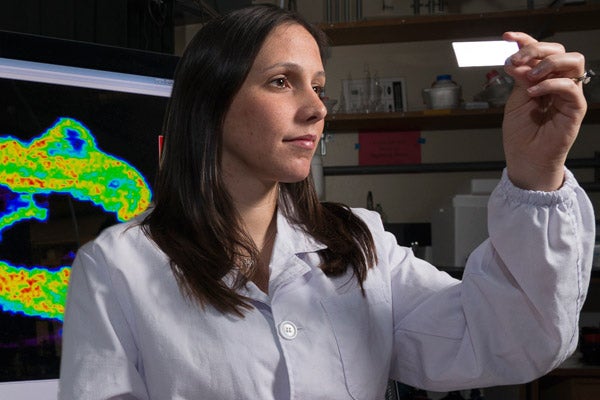|
July 3, 2014
Stanford team creates tool to help unravel secrets of cancer
Using novel methods, scientists identify biological signatures in cancer cells that can be traced back to the original cancer gene. By Shara Tonn

Stanford postdoc Livia Eberlin is the primary researcher in an interdisciplinary Stanford project examining biological signatures in cancer cells. (Photo: Linda A. Cicero / Stanford News Service)
An interdisciplinary team of chemists, oncologists and one statistician at Stanford has taken the first step toward creating a tool that can identify the origin of certain types of cancer – a boon to doctors prescribing therapies for their patients. The research is scheduled to be published in Proceedings of the National Academy of Sciences.
"The same cancer can occur because of different genes, but in certain cases the aggressiveness and the type of treatment actually depend a lot on what oncogene caused that cancer," said Livia Eberlin, a postdoctoral scholar in chemistry and the primary researcher.
An oncogene is a normal gene that has mutated, causing cells to become cancerous. In this study, the team members looked at one that is related to lymphoma and responsible for approximately half of all human cancers. They wanted to find a biological signature that would trace the mutating cancer cells back to the original oncogene.
"When cancer takes place, the cell loves to gobble up glucose – that's a sugar – and glutamine," said chemistry Professor Richard Zare, who served as an adviser to Eberlin. Zare is the Marguerite Blake Wilbur Professor in Natural Science. "It takes those and makes different lipids – different fatty molecules than what it normally makes."
Using an elegant statistical method from Robert Tibshirani, professor of health research and policy (biostatistics) and of statistics, the team was able to identify not just one but 86 lipids that can be traced back to the oncogene.
"It's not just diagnostic," Eberlin said. "It gives extra information that could be prognostic."
Depending on the bio-signature of the cancer cells, physicians will have a better idea of the aggressiveness of a patient's cancer. In the future, this research may lead to a better knowledge of cancer in general.
"The next step," said Dean Felsher, professor of medicine (oncology) and of pathology, one of the team members from Stanford School of Medicine, "is to use this as a way to figure out the causal mechanism." Though the connection between the cancer cells and their origin is clear, the actual cause of cancer – the biological trigger that pushes cancer to progress – is still mysterious.
As Zare mused, "How does cancer really work? This is a tool to understand the nature of how cancer progresses."
Shara Tonn is an intern at Stanford News Service.
For more Stanford experts on chemistry and other topics, visit Stanford Experts.
-30-
|